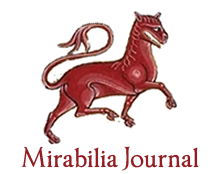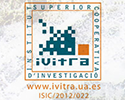The Emotions on the Barcelona Streets of the Fifteenth Century
Cláudia Costa BROCHADO
Original title: As emoções nas ruas barcelonesas do século XV
Published in Emotions in the Ancient and Medieval Mediterranean World
Keywords: Barcelona, Emotions, Fifteenth century, Marriage.
The relationships between the citizens of fifteenth century Barcelona were often turbulent, especially between couples. The conflicts that occurred sometimes resulted in legal proceedings. The statements submitted for these cases were a visible expression of the emotions and conflicts involved. This article presents some of these legal proceedings through partial transcriptions, with the aim of getting as close as possible to the feelings and emotions of the people of Barcelona at the end f the Middle Ages.
The Envy in Curial and Güelfa and its representation in the Middle Ages autumn art
Ricardo da COSTA, Armando Alexandre dos SANTOS
Original title: A Inveja em Curial e Guelfa e sua representação na arte do outono da Idade Média
Published in Art, Criticism and Mysticism
Keywords: Capital Sins, Medieval Art, Medieval Philosophy, Medieval Theology.
In the anonymous chivalric novel Curial and Guelfa (XVth century), the Envy, one of the seven capital sins of the Medieval Septenary, offers a literary background (but also a philosophical-moral one) and is the foundation of both the plot teatralization and the characters poetic construction. As a recurrent theme in Medieval Philosophy, Theology and Homiletics, therefore, the Envy can also be considered as the novel’s leitmotiv. The purpose of this work is to present some initial remarks concerning this theme in Curial and Guelfa, and especially, relate it to some artistic representations of Envy in the period, such as, for example, the Arena Chapel Fresco (1308) of Giotto di Bondone (c. 1266-1337), The Last Judgement (c. 1393), of Taddeo di Bartolo (c. 1362-1422), besides, naturally, the famous iconographic representation of the theme by Hieronymus Bosch (c. 1450-1516): The Seven Capital Sins (c. 1485). To this purpose, our analysis will be methodologically based on the literary narrative method of Johan Huizinga (1872-1945), as exposed in his classic The Autumn of the Middle Ages (1919).
The Evolution of the Main Topics in Ausias March According to the Three-Fold Love Process
Tània ARAGÓ MELIÀ
Original title: L’evolució dels principals tòpics ausiasmarquians en relació amb l’evolució de les tres fases amoroses
Published in
Keywords: 15th century, Ausiàs March, Disappointmentm poetry, Loving failure, Passion.
This article analyzes the writings of Ausiàs March as derived from the concept of ‘failure’ in love. Ausiàs was not interested in the abstract analysis of the different types of love but in the study of his very own nature, as he felt devastated by his dissapointment with love. His verses reveal a personality full of contradictions showing his changing and volatile mood as he focused on three different concepts of love: spiritual love, human love, passionate love. Through the analysis of these three concepts, we try to answer the following question: through his analysis of the secrets of love, was Ausiàs March able to ever find virtue?
The Evolution of the Verbal Form cantara in Catalan: A Textual Corpora Analysis
Carles SEGURA-LLOPES
Original title: L’evolució de la forma verbal cantara en català: un estudi de corpus
Published in
Keywords: Catalan, Historical Grammar, Semantics, Syntax, Verbal Tense.
The analysis of verbal tenses is a well-studied topic in Romance Languages, for which there are excellent studies and monographs in what pertains to the Catalan language. In this article we offer an overview of this topic based on an analysis of several electronic corpora developed within the Institute ISIC-IVITRA or with its participation, such as: the Electronic Corpus of Old Catalan (Corpus Informatitzat del Català Antic [CICA]), the Metacorpus(that is the Electronic Multilingual Corpus of Old and Contemporary Texts, Corpus Informatitzat Multilingüe de Textos Antics i Contemporanis [CIMTAC]), and the Electronic Corpus for the Old Catalan Grammar (Corpus Informatitzat per a la Gramàtica del Català Antic [CIGCA]). We study the forms of the verb cantara from the first examples of its use in the 12th century to the end of the 16th century. Our intention is to identify their main values, describe the progressive development, and determine how and when these forms assumed the typical syntantic functions associated with the imperfect subjunctive that are typical of Castilian and of many of the Valencian varieties of the Catalan language.
The Galician influence in the Romanesque from Alto Minho
Margarita VÁZQUEZ CORBAL
Original title: La influencia gallega en el Románico del Alto Minho
Published in Society and Culture in Portugal
Keywords: Alto Minho, Galician influence, Patterns, Romanesque Art.
The current article deals with the influence of the Cathedral of Tui, its diocesan space and other Galician examples in the Romanesque art from the Portuguese area of Alto Minho. The diocese of Tui encompassed territories from southern Galicia and northern Portugal during a great part of the Middle Ages, in particular, the southwestern area of the province of Pontevedra; southeasthern Ourense and the Portuguese region of Alto Minho. The See from Tui spred a series of artistic and iconographic patterns which were extended in its bishopric and in the adjacent territories, giving the Romanesque in this area its own personality and outside the sociopolitical implications from a borderline in permanent conflict due to the hegemony in both sides of the Miño river.
The Golden Age of Islam: The Abbasid Caliphate Patronage and the House of Wisdom
Carmen Lícia PALAZZO
Original title: A Idade de Ouro do Islã: o mecenato do Califado Abássida e a Casa da Sabedoria
Published in Idea and image of royal power of the monarchies in Ancient and Medieval World
Keywords: Abbasid Caliphate, Baghdad, Golden Age, Islam.
This article analyses some aspects of the so-called Golden age os Islam by following the works of the Abbasid Caliphate, concentrating on the period ranging from the establishment of the capital at Baghdad up to 833, year of Al-Mamun’s death. The House of Wisdom (Bayt al-Hikma) is the most potent image among manifold activities, the memory of which lives on the present day. It bears witness to a period in the History of Islam during Which caliphal power acted as a patron to sciences, philosophy, arts, and literature.
The Hippocratic Oath: a referential preview of contemporary Bioethics
José Benjamim GOMES
Original title: O Juramento de Hipócrates: uma antevisão referencial da Bioética contemporânea
Published in
Keywords: Autonomy, Bioethics, Hippocratic Oath, Professional Code, Sacredness of Life.
This work shows the actuality of the Hippocratic Oath in contemporary days, especially in Bioethics. The great benefices and challenges imposed by the medical science and technology advancement cannot be underestimated. There is a great gap between a highly technic and pragmatic biomedicine and a true humanizing medicine. In the last decades, the risky human experimentation and the medical technology improvement increased even more the risks, the challenges and the conflicts that threat the great ethical values already historically consecrated. The Ethical Medics were reduced to the professional Code, and Deontology itself could not answer to moral conflicts and antagonisms between different philosophical traditions. Bioethics, as a philosophy of biomedical practice and investigation, actually is the space of such discussion, and has in the Hippocratic Oath the origin of its principles and issues. Among the ethical principles in the Oath, the sacredness of life appears as a compromise solemnly proclaimed, without any concession to abortion or euthanasia. Even if such questions are categorically portrayed in the Oath, they remain highly controversial in Bioethics, if we take into account the contemporary interpretation given to principles like autonomy and liberty of the individual. The contemporary ethical pluralism allows different pathways to highly conflictive questions that were already points of conflict in Ancient Greece. Although the controversies of historical and conceptual nature seem to compromise the Hippocratic tradition prestige, its prescriptions cannot be left aside when controversial questions in the fields of Ethics, Science and Medical Technology are raised in the Academy. Although twenty-five centuries separate the Hippocratic Oath from the contemporary Bioethics, the history of medicine shows that it is in this new field of knowledge that the relevance of that ancient text appears. Judged as conservative or even anachronic by some and as an ethical parameter of great importance by others, the Hippocratic Oath still remains as a millenary reference in the ethical stance adopted by Health professionals; and this happens always when such professionals are confronted with the risks, challenges and moral conflicts generated by science and medical technology.
The Hispano-Islamisms of Juan Guas. The fabrication of a Historiographical Stereotype
Roberto GONZÁLEZ RAMOS
Original title: The Hispano-Islamisms of Juan Guas. The fabrication of a Historiographical Stereotype
Published in
Keywords: Historiographical nationalism, Historiography, Islamic influence, Juan Guas, Late Gothic Architecture.
Formalist currents tinged with nationalism in twentieth century historiography developed the idea of Toledo’s late Gothic architecture being imbued with elements and features from Hispano-Islamic architecture, especially in the case of one of its leading lights, the architect Juan Guas. This gave rise to descriptions of a specific, hispanicized style, which had modified its essentially Northern European characteristics. This essay analyses the gradual construction of the aforementioned historiographical viewpoint, its champions, and their arguments and methodological approach. The process can then be reconstructed, with a view to revisiting it and critically analysing underlying assumptions.
The Historical Development of the Logica vetus
Guilherme WYLLIE
Original title: A evolução histórica da Logica vetus
Published in Monastic and Scholastic Philosophy in the Middle Ages
Keywords: History of Logic, History of Philosophy, Logica Vetus, Medieval Logic, Medieval Philosophy.
This paper is a historical survey of the logica vetus, which is distinguished by characterizing and contextualizing the main contributions of the most significant logicians of that period.
The Holy Empire and the Papacy in late medieval thought: some ideas about the precedence in the Italian and Spanish chronicles of the 14th and 15th centuries
Josué VILLA PRIETO
Original title: El Sacro Imperio y el Papado en el pensamiento bajomedieval: algunas ideas sobre la precedencia en las crónicas italianas y españolas de los siglos XIV y XV
Published in Manifestations of the Ancient and Medieval World
Keywords: Cultural History, Empire, History of ideas, Humanism, Papacy, Political thought.
This study analyses the conception of the Holy Roman Empire in the Italian and Spanish chronicles of the Late Middle Ages: origins, authority and tensions with the Papacy for a preeminent position within universal power. After the scholasticism historiographical disputes (XIIth-XIIIth centuries), humanists write new interpretations of the genesis of the Holy Roman Empire wondering about the desappearance (or not) of the Roman imperial potestas and if it continues in Byzantium or the Papacy, and where the Charlemagne's authority comes from. The comparison of the Italian and Spanish sources allows to note different political intentions in a context of mutual cultural influence.






















































































